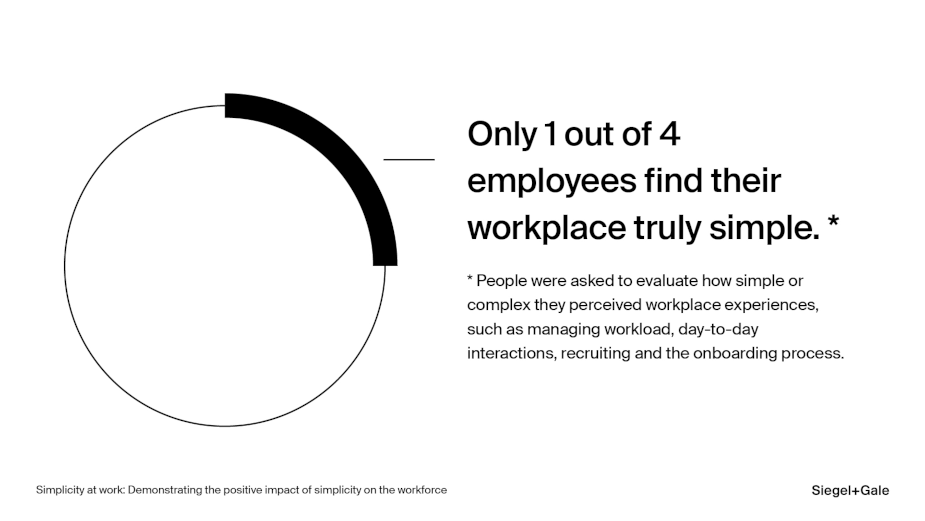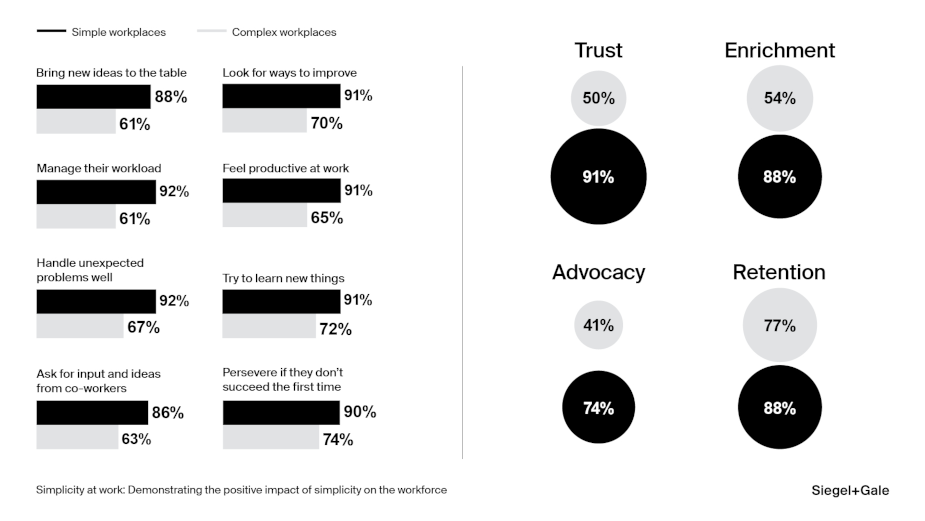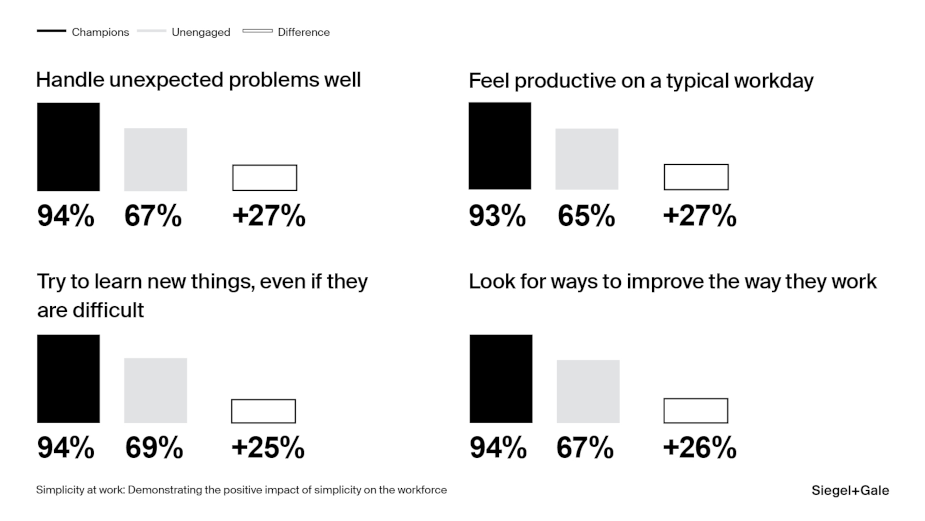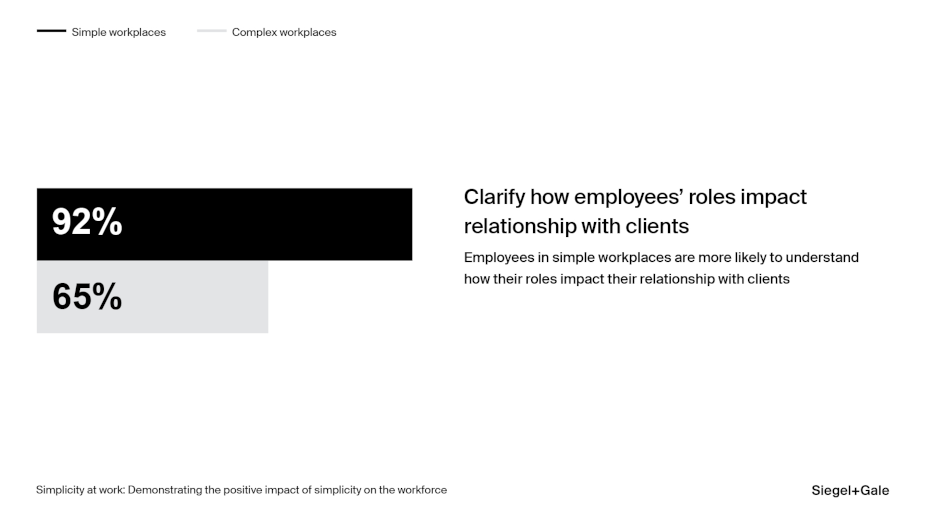This article originally appeared in Little Black Book.
You arrive at work with the best of intentions, ready to have a productive, fulfilling day. You sit down at your computer and can’t find a file your leader suggested you fold into in a report due that day. After spending 10 minutes asking colleagues and searching through various drives, you locate the file, only to later receive vague feedback on your report that doesn’t align with the strategic direction of your company. By the time the day is over, you’re fatigued, frustrated, and ready for a glass of wine.
Feel familiar?
For most of us, the workday is filled with frictions that get in the way of productivity, our well-being, and ultimately better business results.
But it doesn’t have to be this way.
As companies grow, expand into new industries, acquire businesses, and layer in new tools, the complexity increases, adding more friction into the day-to-day for most employees. This complexity is felt by three out of four employees worldwide.

The 25% of employees working in simple workplaces – those where people easily get their work done and feel productive doing so – behave in a unique way. Employees working in this environment go the extra mile. They advocate on behalf of their company, innovate more, and have higher retention rates.

Creating a simple employee experience takes time, intention, and focused effort. Several foundational actions can set the stage for removing complexity, aligning your workforce, and making work easier to do long term. Here are five ways to get started.
#1: Get clear on your brand purpose and values
Employees want to work for a company with a clear purpose beyond financial success. In fact, nine out of 10 employees are willing to earn less money to do more meaningful work . Beyond increasing employee satisfaction, ensuring your company’s brand is guided by an emotionally relevant brand purpose can have big benefits for your bottom line. Companies that are guided by their purpose have 4x revenue growth, 7x job creation, and 12x faster stock price growth. One great example of the impact purpose has is Patagonia, a company that has seen continuous growth over several decades while always putting the planet at the heart of everything it does.
Employees also look for simplicity in terms of how their work is done. For example, decision-making is one of the largest pain points contributing to a complex workplace and employee experience. A strong brand promise paired with clear organizational values can provide a simple filter for decision making, providing clear expectations, helping to align words and actions, and ultimately creating a simpler experience. A good example of this is Netflix’s Culture page, which spells out what the company stands for and clearly defines their values and desired behaviors to set employee expectations well before they even apply for a role.
#2: Find and listen to your brand champions
Brand champions are engaged employees who understand what you stand for and are committed to bringing it to life. According to our research and observations, this group is more likely to look for ways to improve your organization compared to disengaged employees. These employees want their work to matter and contribute to the greater good. If you haven’t already, identify and rally your brand champions and use their input to supplement existing data about your employee experience, such as insights from employee surveys, process improvement initiatives, or external sources like Glassdoor. Your champions will help focus simplicity efforts by identifying quick wins and longer-term initiatives – and possibly help implement them. For example, at Siegel+Gale, some of our brand champions have taken the initiative to re-organize our file structure and naming process, ultimately leading to a simpler work experience.

#3: Focus on moments that matter
After uncovering the current state of your employee experience, select several employee touchpoints to simplify – ideally with input from your brand champions. These touchpoints should be 1) important and emotionally relevant moments, 2) tied to your organization’s brand purpose, and 3) focused on experiences in need of simplification. For example, moments like recruiting, onboarding and promotions are high stakes, and often ridden with complexity in most organizations. Simplifying and amplifying these experiences will result in better employee engagement because they leave a lasting impression and are emotionally sticky.
#4: Get clear on your differentiators and follow through on them
Many companies try to be all things to all people, but that’s simply not possible. You must identify differentiators – elements of your employee experience that set your company apart from competitors. Differentiators can be anything from a professional development opportunity that allows talent to move around the world to encouraging risk taking by celebrating organizational failures. Becoming clear on your differentiators helps create a more cohesive and consistent message to both current and prospective talent. Many companies invest in developing an EVP, or Employee Value Proposition, to help define those differentiators and serve as a critical component of the organization’s talent attraction and retention strategy. The EVP articulates what unique things employees should expect from their employer in exchange for their time and talent.
#5: Close the say-do gap
It’s not enough to identify your differentiators or develop an EVP. While focusing on the words is important to setting expectations, follow-through is even more critical. A seamless work experience requires you to not only make a promise to your employees, but ensure that promise is kept.
Simple, clear, communications not only increase employee engagement, but when they’re strategically connected to your brand purpose and values, employees are more likely to have a seamless experience at work. The gap between what your company says and does is smaller, resulting in less friction and frustration among employees.
Train people managers to connect your brand purpose and values to employees’ daily work. When employees can easily connect the dots between their day-to-day and the bigger picture, they’re more likely to be engaged and understand their role in your workplace.

One example of a company with clear internal expression of their purpose is Google. They have a strong culture of transparency and regularly communicate updates and changes to their employees through company-wide meetings and channels, enabling employees to connect and collaborate across teams and departments. This helps to create a sense of community and shared purpose among employees, which can lead to increased engagement and a better employee experience.
Ultimately, the key to a simple, more fulfilling workplace is to make your employees’ experience a priority and to ensure that what you say and do is aligned with the company’s brand purpose and values. By doing so, companies can keep those frustrating workday frictions to a minimal and help ensure employees feel happy and engaged.
Learn more about the positive effects of simplicity on the workforce through our latest report, Simplicity at work.


